Using "C" setting
First, set the mode selector to "C," and remember the number shown on the
frame counter of the motor drive.
1. Push the rewind slide up as far as it will go. Hold the slide in the "up"
position for the duration of the shooting session.
2. Trigger the motor drive for the required number of exposures or until the action
you are following has finished.
3. Release the rewind slide, cover the lens and make two blank exposures.
4. Reset the frame counter of the motor drive to read one frame less than the number
shown before making the multiple exposures.
 |
Note: 1) You can always verify the correct number of exposed frames by referring -to the camera's frame counter. The camera's frame counter only advances as the film is transported, providing you with a reliable means of determining the number of frames exposed. 2) You can also get multiple exposures by pushing the rewind slide up and then releasing it before each exposure. |
Pushing up and releasing the
rewind slide during this operation tends to shift the film frame slightly, although
this is insignificant (0.2mm shift), but you can avoid it all together by holding
the slide up throughout the sequence.
Motor
Drive Operation Timing
When performing various operations using an intervalometer or similar device connected
to the cord less-battery pack-equipped motorized camera, certain timing factors must
be taken into consideration to achieve proper results. For each special shooting
situation, weigh each factor carefully and make compensation adjustments in timing
as necessary.
A time lag exists between the triggering of the camera (via the remote control device)
and the actual release of the shutter. When the mirror is locked up, this delay is
0.03-0.05 sec.; when the mirror is coupled, however, the delay is extended to 0.05-0.07
sec. Note that for the mirror-coupled condition, the time delay varies slightly depending
on the power source and voltage.
 |
The following illustrations show how to obtain the correct timing interval. |
When the mode selector ring
is in the "C" position, the on/off switch opens and closes the trigger
circuit as shown below. Usable shutter speeds are from X (1 /80) to 1/2000. The value
for T varies according to the power source used, but must be greater than the time
interval shown in the table below.
|
Power source |
MB-1 |
MB-2 |
MA-4 |
|
|
Penlight |
MN-1 |
|||
|
Time interval |
0.32 |
0.28 |
0.45 |
0.28 |
When the mode selector ring is set at the "S" position, the trigger circuit is opened and closed as shown below. The motor drive will begin to make exposures at a predetermined interval. Any shutter speed can be used.
 |
For exposures longer than one second, use the "B" setting. At this setting, exposure time is almost equal to the time required to close the trigger circuit ( t t ). |
Remote Control Operation Remote Cord MC-4 The motor drive can also be triggered by connecting the Remote Cord MC-4 to its remote terminal. The shutter will be released by contact between the two ends of the remote cord. An extension cable can also be connected; any length is acceptable, so long as the circuit resistance does not exceed 100 ohms.
 |
|
Intervalometer MT-1 This timing control device enables various special-effects photographic techniques such as time-lapse, work-sampling, time-exposure and delayed-exposure. Its output socket should be connected to the remote terminal on the motor drive via the Extension Cord MC-S.
Radio Control Set MW-1 The Radio Control Set MW-1 is an FM wireless remote control device to operate the motor-drive-equipped camera at distances up to 0.7 km in open, unobstructed areas, and up to 0.3 km in urban or mountainous areas. It can operate up to three cameras, either individually or simultaneously.
Modulite Remote Control Set ML-1 Connect the receiver of the Modulite Remote Control Set ML-1 to the remote terminal on the motor drive via the Connecting Cord MC-8. Using the Modulite Set, you can perform remote control operation over a distance of up to 60m.
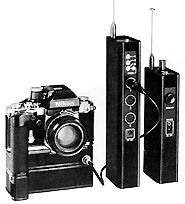 |
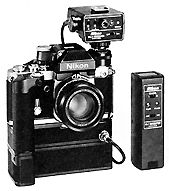 |
The receiver only responds to a modulated light signal from the transmitter, so the possibility of inadvertent triggering due to the influence of speedlight or other bright light sources is eliminated. |
System Accessories (Also see accessories section.)
Quick Charger MH-1 The MH-1 recharges 70 to 80 percent of the power of the NC Battery Unit MN-I in approximately three hours. There are four acceptable levels of input power, namely 100v, 117v,220v, and 240v.
 |
Shutter Release MR-1 |
It is also threaded to accept
the Nikon Cable Release AR-2 for copying and still life operation. Also see MR2 .
Pistol Grip Model 2 The Pistol Grip Model 2 (available as an optional
accessory) provides comfortable support for fingertip operation of the motor-drive-equipped
Nikon F2-series camera powered by a cordless battery pack. It is particularly useful
for a telephoto lens, a zoom lens or a Reflex-Nikkor lens provided with a tripod
mounting collar. The pistol grip is connected to the remote terminal on the motor
drive via the Connecting Cord MC-3.
Battery Pack jacket MA-3 The Battery Pack jacket MA-3 is felt-lined and leather clad to provide the batteries inside the Cordless Battery Pack MB-1 with necessary protection against the cold.
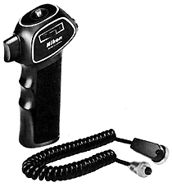 |
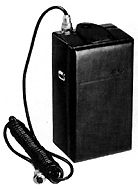 |
It ensures that the motor drive will continue to work at peak efficiency. The two straps affixed to the jacket allow it to be slung from the neck, shoulder, or waist. |
Specifications:
Suitable camera: Nikon F2-series camera
Shooting mode: Single-frame or continuous (max. 36 frames)
Shooting speed: 4 fps. max. (using MN-1 NiCd units or AC/DC converter)
Frame counter: Subtractive type Possible to preset the desired number of exposures.
Automatic motor stop when the frame counter reaches zero
Usable shutter speeds:
1/80-1/2000 sec. (continuous)
1 -1 /2000 sec. plus B (single-frame)
Power sources:
DC supply between 12 and 15 volts; Cordless Battery Pack MB-1; Cordless Battery Pack
MB-2; AC/DC Converter MA-4
Remote control: Possible; uses the remote terminal on the MD-3, connected
via a connecting cord.
Dimensions: Approx. 147 (W) x 106 (H) x 62 (D) mm (including the grip)
Weight: Approx. 355g
Optimum Battery Performance.
I . New batteries: Between manufacturing and first use, all batteries exhibit
some drain. Therefore, care should be taken to purchase the newest (and freshest)
ones possible. To help you do this, some manufactures stamp the date of manufacture
on the bottom of each battery; ask your camera dealer for assistance in interpreting
the codes.
2. Temperature: Battery life ratings are based on operation at around 20'C
(68'F). At other temperatures, battery life is shortened. At NiCd, for instance,
battery life is shortened by as much as 2/3. Spare batteries should therefore be
kept available if operation in low temperatures is anticipated.
3. Continuous use: Batteries are drained much more quickly by continuous use
than by intermittent use.
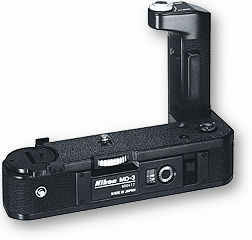 |
4. Storage: When not in use, the batteries should be removed from the cordless battery pack to prevent damage by. leaking. To minimize drain during the period of disuse, store the batteries in a cool, dry place. 5. Battery brands: Do not use mixed brands of batteries, nor batteries with different model numbers. Also, avoid mixing new and old batteries since proper performance will not be obtained and battery leakage into your MD-3 may occur.6. Disposal: Do not dispose of batteries by burning. Also, for safety's sake, do not disassemble batteries when disposing. 7. Polarity: When installing batteries, observe the voltage polarities carefully. Reversal of the positive (+) and negative (--) terminals will result in leakage. If leakage should occur, clean carefully or take your MD-3 to your dealer. |
 |
Recently, Mr. Bob Hammond <bobham@tbaytel.net> sent me an interesting image of the two versions of Nikon MB-1 which made me have a second thought of concluding there is only one version.. . Click on the thumbnail to see an enlarge view of the two MB-1. |
| PREVIOUS |
3/3
| Nikon MD-1
| MD-2
| MD-3 | MD-100
|
| System Accessories for Motor Drives |
| Back | Main Index Page - F2 Motor Drive Options
| Message Board |
for
your favourite Nikon
F2 Series SLR model(s)
| Message Board | for your Nikon Optics in a shared environment
| Message Board | Specifically for Dispose or Looking for Nikon/Nikkor Photographic
Equipment
| Back | to Main Index Page of Nikon F2 Series SLR models
| Back |
Main Index Page of Pictorial History of Nikon SLRs
 |
The Eyes of Nikon:- |
Fisheye-Nikkor Lenses - Circular | Full Frame | Ultrawides Lenses - 13mm15mm18mm20mm | Wideangle Lenses - 24mm28mm35mm |
Standard Lenses - 45mm 50mm 58mm | Telephoto Lenses - 85mm105mm135mm180mm & 200mm |
Super-Telephoto Lenses - 300mm 400mm 500mm 600mm 800mm 1200mm |
Special Application lenses:
Micro-Nikkor Lenses - 50mm~55mm -60mm 85mm -105mm 200mm Micro-Zoom 70-180mm
Perspective Control (PC) - 28mm 35mm PC-Micro 85mm
Dedicated Lenses for Nikon F3AF: AF 80mm f/2.8 | AF 200mm f/3.5 EDIF
Depth of Field Control (DC): 105mm 135mm
Medical Nikkor: 120mm 200mm
Reflex-Nikkor Lenses - 500mm 1000mm 2000mm
Others: Noct Nikkor | OP-Nikkor | UV Nikkor 55mm 105mm | Focusing Units | Bellows-Nikkor 105mm 135mm
Nikon Series E Lenses: 28mm35mm50mm100mm135mm | E-Series Zoom lenses: 36~72mm75~150mm70~210mm
MF Zoom-Nikkor Lenses: 25~50mm | 28~45mm | 28~50mm | 28~85mm | 35~70mm | 36~72mm E | 35~85mm | 35~105mm | 35~135mm |
35~200mm | 43~86mm | 50~135mm | 50~300mm | 70~210mm E | 75~150mm E | 80~200mm | 85~250mm |
100~300mm | 180~600mm | 200~400mm | 200~600mm | 360~1200mm | 1200~1700mm
Tele-Converters: TC-1 | TC-2 | TC-200 | TC-201 | TC-300 | TC-301 | TC-14 | TC-14A | TC-14B | TC-14C | TC-14E | TC-16 | TC-16A | TC-20E
![]()
Nikon F
| Nikon F2 |
Nikon
F3
| Nikon F4 |
Nikon
F5
| Nikon F6 |
Nikkormat / Nikomat |
Nikon FM
| Nikon FE/ FA | Nikon EM/FG/FG20 | Nikon Digital SLRs | Nikon - Other models
MIR Supports for Photographic Community: Various Message Boards/Community
Forums
Nikon
F-series|
Nikon
F2-series|
Nikon
F3-series|
Nikon F4-series| Nikon
F5-series|Nikkormat/Nikomat-series
Nikon FM-series|Nikon
FE-series|Nikon
FA|Nikon
Digital
SLR
series|Various
Nikon
Models|Nikkor
Optic
-shared
Others:- Free Trade Zone - Photography| Free Trade Zone - Business Community |Free To Zouk - Photographic Community
Apple's Mac Public Community Message Board | Windows based PC &
Apple/Mac
Public Community Trade Exchange Centre
Recommended links to understand
more technical details related to the Nikkor F-mount and production Serial Number:
http://rick_oleson.tripod.com/index-153.html by: my friend, Rick Oleson
http://www.zi.ku.dk/personal/lhhansen/photo/fmount.htm by: Hansen, Lars Holst
http://www.mir.com.my/rb/photography/hardwares/nikonfmount/lens2.htm
http://www.photosynthesis.co.nz/nikon/serialno.html
About this photographic site.
HOME - Photography in Malaysia |
Copyright © 2000. leofoo ®. MIR Web Development Team.
In
memory of my friend Com.
Augusto Staut,
Brazil, 1971-2000.
Credit: Chuck Hester, US for his patience, encouragement
and help to setup the various content in this site; Robert Johnson for some of his original
images on the F2H-MD appeared in this site; my ex-staff, KiaSu for his superb
3-D logo appeared in this Nikon F2 site; Marc Vorgers from Holland who
generously provide me with some of his images of F2AS; MCLau®, who has so much time with me to
re-edit the content in this site and not to mention buying a Nikon Coolpix 990 just
for this site. Keat Photo,
Kuala Lumpur for providing
their Nikon F2A to take some images for this site; again, Mr Edward Ngoh the
great camera collector who provides us his collection of F2AS with MD-2; hawkeye.photographic.com
for their images on the Speed Magny film backs; Sean Cranor for his image
on Nikon F2 25th Anniversary Model; Ted Wengelaar®, Holland for his continuous
flow of input on some of the early Nikon bodies; CYLeow ® , photo editor of the Star
newspaper, Malaysia for some of his images used in this site. Ms Rissa Chan, Sales manager from
Shriro Malaysia who has helped to provide some of the very useful input. HiuraShinsaku®,
Nikomat ML, Japan for some of his images on various F2 models; my staff, Wati, Maisa, Mai and my nephew, EEWyn®, who volunteered and helping me
did so many of the film scanning works. Contributing photographers or resellers:
Jen Siow, Foo KokKin, Arthur Teng, Mark Fallander, John
Ishii, Ed Hassel, YoonKi Kim, Jean-Louis, M.Dugentas (Dell Corner.com.), Mr "Arsenall" and a few images mailed
in from surfers with no appropriate reference to their origin. Dedicated to KU Yeo, just to express our mutual regrets over the outcome of
a recent corporate event. Made with a PowerMac, broadcast with a Redhat Linux powered server.

